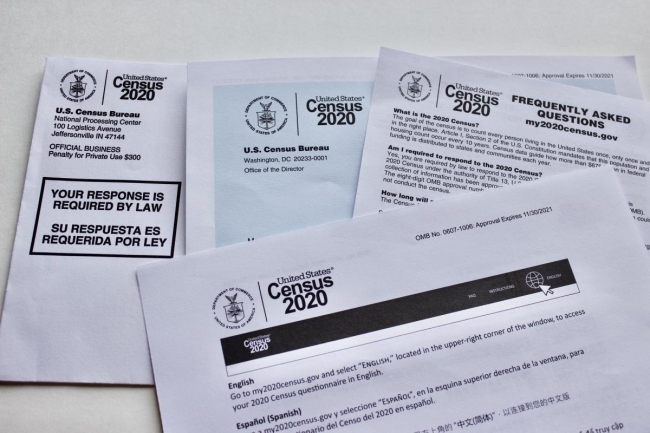You have /5 articles left.
Sign up for a free account or log in.

ISTOCK.COM/Lawrence Glass
The evacuations of college campuses this spring could not have come at a worse time.
The U.S. Census Bureau had been coordinating with college administrators and local government officials across the country to get an accurate count of students in their communities. Colleges had planned outreach efforts as the official decennial count got underway on March 12.
All of that planning and preparation came to a complete halt as colleges started sending students home or telling them not to return to their campuses after spring break. The massive and hurried effort to prevent the spread of the coronavirus has had some unintended consequences. Many college towns are already reporting lower census response rates this year than during the last decennial Census in 2010.
“We were going to build two weeks until April 1, which is considered National Census Day,” Harriett Steinbach, assistant director of service learning at Illinois State University, said of plans for her campus. “We were going to be on the quad on April 1 with the folks from the Census Bureau. They have a mobile station with tablets, and the intention was to have people to do the Census right then. Obviously, none of that happened.”
Undercounting college students and other residents has serious implications. Millions of dollars in federal funding for college towns and cities over the coming decade and apportionment of seats in the U.S. House of Representatives -- all of which are calculated based on population rates -- are at stake.
Steve Patterson, the mayor of Athens, Ohio, home of Ohio University, estimates that it could cost his city $20 million in federal funding over the next 10 years if even half of the students who graduated from OU this spring are not counted in the Census.
Patterson highlighted one Census tract in Athens where the response rate of people who filled out census questionnaires on their own in 2010 was 47.6 percent; as of July 29 of this year, it was 30.9 percent. Similar trends are being reported by many college towns this year, he and others said.
“Here in the state of Ohio, we put together a group about two months ago we’re just calling the Ohio College Town Coalition,” Patterson said. “I’m hearing the same narrative coming from all of them. They are all seeing the same thing -- undercounts that were vastly different than what they were in 2010.”
Steven Romalewski, the director of the City University of New York Mapping Service, which publishes a “Hard to Count” map tracking census response rates across the country, echoed that anecdotal observation.
”We haven’t examined college towns systematically, but we have noticed visually and anecdotally that response rates around colleges and universities have been low in some areas,” he said.
There’s still plenty of time to respond to the Census -- the deadline has been extended until Oct. 31 -- and colleges are trying to get the message out to students to submit the Census for the address where they would normally have been living on April 1, even if the pandemic forced them to leave campus before that date.
The Census has also stepped up its outreach to colleges. Institutions have long had the ability to provide data for students living in dorms and other on-campus housing (so-called group quarters) directly to the Census. In June, the Census took the additional step of reaching out to colleges asking them to provide roster information for students living off campus.
“This information allows the Census Bureau to count the students where they would have been staying on April 1, 2020, even if they went home early due to a school closure or shift to distance learning,” the Census Bureau said in a written statement. “We are only asking about those who were students on April 1, 2020. A complete submission with detailed information allows the Census Bureau to provide a more accurate census of the local community where the college or university is located.”
But Stephanie Reid, the executive director of Philly Counts, a citywide initiative in Philadelphia focused on the 2020 Census count, said colleges providing address information for students living off campus might not prove to be as helpful as she originally thought.
“We thought it might be a tool we could use to help fill in the data, but once we talked some more with colleges and universities, what we found is most of them don’t have [local] addresses for off-campus students,” Reid said. “Most students give them the home address of their parents.”
Reid said of the nine colleges in the city she'd had conversations with, not one of them thought they could pull together the data.
It may vary by college whether they have the data. The Census Bureau said it requested data from about 1,200 institutions, excluding commuter colleges and institutions that do not have students living off campus. As of July 28, 623 colleges and universities had agreed to submit data on their off-campus student populations, and 318 had already done so.
Carah Ong Whaley, associate director of the James Madison Center for Civic Engagement, at James Madison University in Virginia, said she thought the new ability for colleges to submit data for off-campus students will "help a lot for communities concerned about undercount."
Still, she stressed that because of federal privacy laws, colleges can only turn over what's considered "directory information," and there is additional information -- about race and gender, for example -- that won’t be collected unless students also submit the form themselves.
“Even though we know this directory information will alleviate local concerns about count, I think it’s still incumbent upon higher education to have students learn about it and fill it out completely,” Ong Whaley said.
Ong Whaley and others described having to retool their outreach efforts to a virtual environment.
"We had planned to do in-person classes to educate about the Census and why it mattered and give students the opportunity to complete the Census during course time," Ong Whaley said. "We had to switch to offer a virtual presentation. I think that was just not as effective."
Katharine McCormick, director of civic engagement for the City Colleges of Chicago, said she’s been focused on ways to “piggyback on existing channels” in order to reach students.
“We’re trying to look for existing communication channels and also who our trusted messengers are,” she said. Among the ideas, she said, are preparing academic advisers to give students a nudge about the Census.
"The fact that nobody’s on campus, you don’t have these centralized points where people are coming together and you can get a lot of bang for your buck in terms of effect, I think that's a problem," McCormick said of the difficulties of doing Census outreach in a virtual environment. "Just in terms of the sheer inundation of everything that is virtual because classes are virtual, student supports are virtual, friends, communication are virtual, it’s definitely getting lost in the noise."
Anita Banerji, director of the Democracy Initiative at Forefront, a Chicago-based organization involved in Census outreach, said "college students have become one of the hardest-to-count populations now given the COVID crisis and the displacement of college students."
“There’s already not enough education out there that college students that live on campus communities nine months of the year should be counted in these college campuses during a decennial census,” Banerji said. “Just as we had trusted community leaders, student leaders and university officials embarking on that outreach, we had to pivot quickly.”
"That has left a number of college students not being accounted for in the college towns. Although universities have reached out to folks and asked them to go into the online portal and to self-report using the address of their college towns, many folks haven’t done so," she said. "Many folks are being counted with their families’ households at their permanent addresses, and there’s just a general lack of coordination."
Beth Lynk, the director of the Census Counts Campaign at the Leadership Conference Education Fund, said it's important students are counted where they go to school so that college towns and cities don't miss out on resources and political representation for the decade to come.
“The Census supports distribution of over $1.5 trillion in funding,” Lynk said. “It’s really important that college students participate. It’s a way to not only ensure that political power and resources go where they need to be, it’s also a way to give back to your college town by making sure you’re counted in the right place.”








